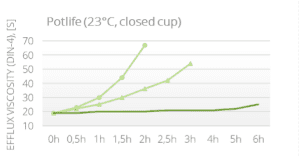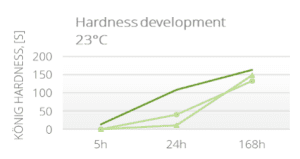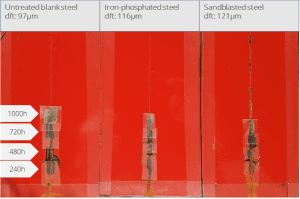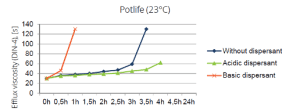More news
- Focus on the global coatings market: Global coatings market outlook
- View from the UK: Navigating chemical policy and sustainability
- Focus on adhesives: Unveiling unbreakable bonds – Testing redefines physical strengt...
- Focus on adhesives: Henkel and Covestro collaborate for sustainability of engineered wood ...
- Advances in construction chemical technology: What’s new in 2024?

Oliver Truchses, allnex, discusses the benefits of fast cure technology for industrial applications
During inflationary times, profitability is under pressure, and companies struggle to justify investments. To overcome this, production speed is key in delivering CAPEX efficiency. This is relevant for OEMs, job-coaters, and even in field-applied conditions. Over the past years, allnex has introduced a number of new technologies, reducing drying and handling times from an original 6-8 hours for high solids 2K PU systems in forced drying, down to 2.5 hours at room temperature.
A new trend has emerged related to energy efficiency and reduction in carbon footprint across scopes 1, 2, & 3. With a new development in Fast Cure (FC) technology, drying and handling can be completed at room temperature in just 1 hour. This technology can be applied to various applications, ranging from heavy-duty equipment to body shops.
Fast cure polyesters
Equipped with innovative Fast Cure (FC) technology, a new range of polyesters now enables the formulation of 2K PU coatings, providing significantly improved early hardness and extended working time as compared to similar state of the art 2K PU HS systems. The application field for these products is typically found in heavy duty equipment, agricultural machinery and other areas which require DTM, high gloss with good mechanical and chemical resistance. Benefits of this technology include:
- Higher cure speed through higher catalyst loading
- Strongly improved early hardness without sacrificing final hardness
- Improved working time and reduced paint
Demonstrated in a clear coat formulations the FC polyester allows for higher quantities of catalyst to significantly boost early hardness while potlife is even increased vs. high solid standard polyesters with a similar OH%.



Related to the polymer design, these new polyester, when crosslinked with aliphatic polyisocyanate hardeners, provide excellent outdoor durability. In comparison to high solid acrylic references, (Standard acrylics; FC acrylics in a white pigmented formulation the FC polyester provides further increased paint solids and lower paint VOC content.[1] ) either at room temperature or forced cured conditions (30 min 50°C or 80°C) an outstanding drying performance with fast early hardness build up can be achieved. Depending on the chosen FC polyester system, very high MEK resistance can be achieved at room temperature and forced cured conditions. Additionally, the FC polyester with an OH% above 6.0% displayed superior corrosion resistance on various widely used substrates in the protective industries like untreated steel, iron-phosphate steel, sandblasted steel and even on more challenging substrates like untreated smooth steel.
Below, the salt spray performance of a red Direct-to-Metal (DTM) mono coat could be seen. The coating was cured for 30 min at 80°C and left for 1 week at room temperature. Subsequently panels were exposed to salt spray testing for 1000 hours. Hardly any blisters could be observed in combination with excellent adhesion presented in a very low delamination at the cut.

READ MORE:
Reintroducing the wheel: Linseed paint as the natural option
Formulation advice
The chemistry of FC resins allows usage of higher levels of tin catalysts to speed up curing, while still keeping a good pot life. Too high levels of tin catalyst might, however, lead to (too) fast curing of the coating surface. This can result in more solvent retention with the risk of dieback and, in the end, lower coating hardness. Therefore, it is important to choose the right balance between the amount of catalyst and/or slow solvents and take into account the preferred application (e.g. RT vs 60°C cure). Safety and health concerns about the use of (high concentrations of ) tin catalysts, moreover, must also not be forgotten: in this respect, application of FC cure technology to tin-free systems is currently under study.
In combination with the recommended higher levels of tin catalyst, bases and more specifically amines can also be used to fine-tune performances: higher concentrations of such components will result in reduced tack-free time, but also in shorter pot life and lower end hardness. Addition of acidic components, on the other hand, will result in prolonged pot life, longer drying times and lower early hardness.
When choosing formulation components, paint formulators should consider that their acidic or basic properties can impact the coating performances. The below shown graph illustrates the use of different dispersing agents within the FC polyester technology, resulting in a significant different observed potlife at room temperature.

Beside the shown effect on the potlife, acidic or basic components will have a certain effect on the drying performance and hardness development.
Conclusions
In general, all resins in the new allnex FC polyester product range have the following features:
- Fast drying at room temperature or elevated temperature for shorter cycle times and increased profitability
- Exceptionally long pot life and working time
- Excellent early hardness
- Excellent appearance
All this, combined with very good chemical resistance, mechanical properties and outdoor durability.
The combination of these special features and advantages of the FC product range is also visualised in the spider diagram below for the two existing FC polyester with a different OH% (on solid resin) either at ambient cure or forced curing (30 min 80°C).


![]()
allnex has used the FC technology platform, which was developed in the beginning for fast cure acrylics used in vehicle refinish clear coats and transformed this novel approach into polyesters which demonstrated exceptional performances in pigmented top coat applications for general industrial and DTM applications.
FC products can also be used to contribute to more environmentally friendly processes, enabling lower temperature curing conditions and saving energy consumed by the ovens. Application of FC products can be further extended to other markets, such as ACE and marine & protective. FC -compatible sag control agent-modified resins for OEM applications are also currently under development.
For more information: Oliver.Truchses@allnex.com
[1] All formulations where tested with an HDI-Trimer isocyanate (NCO/OH: 1,0); DBTL catalyst levels were optimised for each formulation for best overall performance; pigment (TiO2)/binder ratio was 0,8:1.







